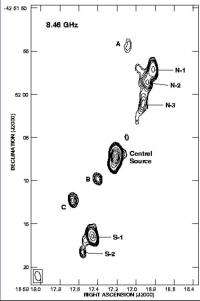Making Massive Stars

(PhysOrg.com) -- Our understanding of star formation leans heavily on observations of stars like the sun, namely, those that are modest in mass and that are born and evolve at a relatively leisurely pace.
By way of contrast, more massive stars mature so quickly that both observations and theory are hard pressed to follow their progress in detail. In the current theoretical description of star formation, a central protostar accretes material from a circumstellar disk that in turn is surrounded by a much larger, more nearly spherical envelope of infalling dust and gas. One result, a consequence of the star's spin, is that the young star produces polar jets of ionized gas and molecular outflows during its early stages of evolution. These outflows are widely seen, and are important markers of stellar youth. The issue for astronomers is whether this basic paradigm also applies to the formation of all stars, including massive stars, or whether there might be other processes at work.
It is possible that massive stars are formed by processes that are radically different from those that produce low-mass stars. One suggested alternative, for example, is formation via the merging of lower mass protostars. If massive stars are formed by accretion processes like those in low mass counterparts, astronomers expect that disks and jets will also be present during their earliest stages of evolution. On the other hand, if they are formed through coalescence of lower-mass stars, then neither disks nor jets are expected since they would be disrupted during the mergers.
SAO astronomers Ramiro Franco-Hernandez and Jim Moran, together with two colleagues, used the Submillimeter Array and other radio telescopes to probe the star formation activity in one region shining with the brightness of about 62,000 suns and known to be the site of massive young stars. They observed the detailed motions of the gas clouds in the region by looking at emission from masers. Masers are the radio wavelength analogues of lasers; because the maser emission is so bright and monochromatic, small motions of the maser gas can be detected and then modeled.
The maser emission in this region reveals evidence of multiple sources in the central, massive source along with outflow activity and a rotating structure. The scientists estimate that the mass of the central source is around 30 solar masses. The results suggest that the formation of this source, one of the most luminous protostars (or perhaps cluster of protostars) known, is taking place with the presence of ionized jets and disk-like structures in much the same way that lower mass stars form.
Provided by Smithsonian Astrophysical Observatory


















